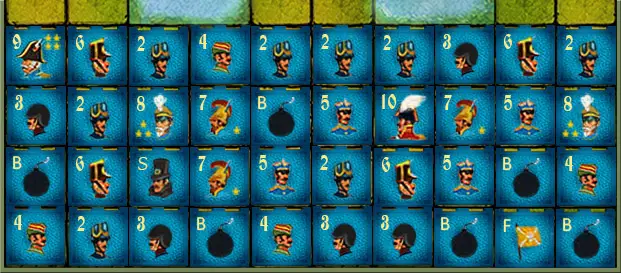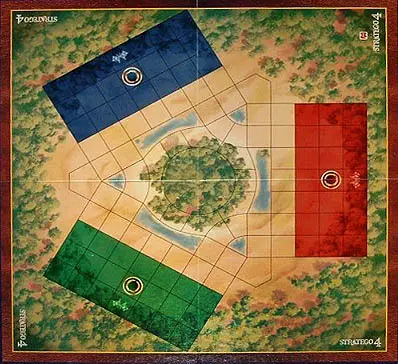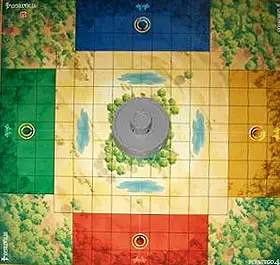This document attempts to describe the game Stratego, also known as L'Attaque, which is very closely related to its predecessor Gunjin Shogi ("Japanese Military Chess"). Other variants exist, such as Dover Patrol, Aviation, Tri-Tactics, Do Shou Qi ("jungle,") Lu Zhan Qi ("Land War,") Hai Lu Qong Zhan Qi ("Air Land Sea War,") Game of the Generals, and so forth.
There are notational convention differences between the American and European versions, as well as various published editions, which do not impact the game (by example, the numbering of the pieces points in opposing directions.) This document need not concern itself with such things, and will use the basic American conventions, because coffee.
What is described here is "Classic Stratego." Many software implementations instead implement "Electronic Stratego," which has important rules differences mentioned at the end.
Stratego is a game for two players, here called red and blue, played in
alternating turns. Stratego takes place on a square board partly filled with
pieces belonging to either player, and takes place in alternating turns.
Stratego pieces have a "value." This value is either on the order 1 ... 10,
or of two special values B and F. Each player has a fixed count, most
multiple, of each of these kinds of piece, and the player places the pieces in
their region as they see fit. Higher numbers are stronger, and will win in a
direct conflict, with a few exceptions.
Crucially, Stratego is a game of incomplete information, based on these values: the values determine the relative strength of two pieces in a combat, and those values are hidden until a combat takes place (in the phyiscal game, this is by writing the value only on one side, facing the owner, and revealing it by turning it temporarily.) Because the players only learn one anothers' placements through combat, there is substantial guesswork and the opportunity for bluffing in gameplay.
In the traditional physical game, pieces are turned back after the combat, creating a memory game. (However, in a network instance there is no practical way to police cheating by note taking, so this should probably be something the game just tracks on screen for both players, to enforce fairness, with a voluntary disabling flag.)
The goal of Stratego is to capture the enemy player's flag. A capture takes
place when two pieces fight. Two pieces fight when one piece moves into the
cell of another piece. Except the Scout, pieces move a single square H/V at
a time, one per turn. Scouts may move any distance H/V, but may not jump over
other pieces or lakes. Your own two pieces may not fight, or jump over each
other, or trade spaces. When two pieces enter the same cell, except in a few
special cases, the higher value wins, and the lower value piece is permanently
removed from the board and from play. If the two pieces in combat have matching
values, they are both removed.
Those two special cases:
- Mi
ner (3) can defeatBomb, which cannot move and otherwise defeats every piece. XSpy (1) can defeatMarshall (10), which otherwise defeats every piece butBomb.
Strategy and tactics in Stratego primarily come from determining the enemy's internal structure, then from establishing a path to clearing to its flag.
A tie game end state is technically possible, but extremely difficult to attain. Most players are not able to describe a mechanism for a tie. For all intents and purposes, this game should be thought of as generally not having a practically attainable tied state.
This document only concerns itself with the default Stratego arrangement. However, alternate arrangements exist, for more than two players, larger or smaller piece rosters, et cetera; a good implementation would be ready for these.
The default board is 10x10 with two 2x2 "lake" holes towards the middle. Each player is considered to initially own the three ranks of the board nearest them, and will fill them entirely with 40 pieces.
1111111111
1111111111
1111111111
1111111111
..~~..~~..
..~~..~~..
2222222222
2222222222
2222222222
2222222222
In this notation, 1 is a cell that player 1 should fill prior to gameplay;
2 is a cell that player 2 should fill prior to gameplay; . is an empty
cell which can be used; ~ is a water cell, which must never be entered or
crossed over.
There are gameplay labels for the values' numbers to maintain theme, and the
ones for 1, 2, 3, and 10 are important, so we will use those instead of
the numbers, leaving a practical range of 4 ... 9. The labels collide in
letter on M and S, so we'll also use N and X: Marshal for 10, Miner for 3,
Scout for 2, and X Spy for 1.
Conventionally, Bomb is ordered above the numbers, and F below the numbers,
where the "top" of the numbers are the highest ranked Marshals.
As such, our pieces are [F, X, S, N, 4, 5, 6, 7, 8, 9, M, B].
| Rank | Symbol | Name | Count per player | Special properties |
|---|---|---|---|---|
| B | B | Bomb | 6 | Immovable; beats every piece but MiNer |
| 10 | M | Marshal | 1 | Can be captured by the X Spy |
| 9 | 9 | General | 1 | |
| 8 | 8 | Colonel | 2 | |
| 7 | 7 | Major | 3 | |
| 6 | 6 | Captain | 4 | |
| 5 | 5 | Lieutenant | 4 | |
| 4 | 4 | Sergeant | 4 | |
| 3 | N | Miner | 5 | Can capture Bombs |
| 2 | S | Scout | 8 | Can move any distance H/V, no jumps, no lakes |
| 1 | X | Spy | 1 | Weakest piece, but can capture the Marshal |
| F | F | Flag | 1 | Immovable; capturing this ends the game |
Pieces may never cohabitate. Every piece is in exactly one cell at any time. There is no jumping. All moves except the scout are single step, non-diagonal. The scout moves as the rook in chess. No piece may enter or cross over the lakes. No piece may enter the same cell as another piece of the same player. Pieces entering the cell of an enemy player's piece initiate a combat, during which one of the two pieces is immediately and permanently removed.
Play takes place in two phases:
- Setup
- Play
During the setup phase, each player begins by placing their pieces, values all hidden, in their side of the board. In the default Stratego board, there are exactly the total count of pieces needed to fill the player's side three ranks of the board. Pieces may not cohabit cells. All pieces must be deployed. In a correct initial board state, no cells on either player's side will be empty, and all cells in the middle two ranks will also be empty.
There is no particular structure to the setup phase; just get it done, don't worry about trading off or taking turns placing or whatever.
Much of the goal in choosing a starting layout is to place pieces to defend your own flag. Much is in placing pieces or piece groups to attack the remote flag. The remainder is mostly bluffing.
Here is an example of a single player starting layout:
We would write that:
96S4SSSN6S
NS87B5M758
B6X75S65B4
4SNB4NNBFB
One might make the argument that by retaining bombs around the flag to the back rear, then front prepping that with scouts and stromger pieces, that the player making this arrangement is attempting to provide a miniature fortress, and attempting to prevent enemy miners from getting to those defending bombs.
The opposing player will make something similar on their side.
Game proceeds with red player moving first. It is believed that first player advantage in Stratego is nearly non-existant. Passing and zugzwang are not permitted. Players take alternating turns.
Game proceeds until one player's flag has lost a combat.
Many variants exist.
Alternate board layouts do exist. Various two-player editions offer larger boards for advanced players, or smaller boards for younger players.
This is a three-player board (note the triangular arrangement:)
This is a four-player board:
Smaller boards for "Stratego Lightning," "Stratego Junior," "Barrage Stratego," "Stratego Arena;" larger boards for "Stratego 4", "Ultimate Stratego," "Strategia;" larger boards and special pieces for "Stratego Waterloo," "Stratego Shogun," "Stratego Naval," "Stratego Legends." There exists a largely unrelated co-branded card game "Stratego Battle Cards" which may be safely ignored.
Despite total lack of rules overlap, Stratego Naval is weirdly reminiscent of battleship.
Good variant board support can probably just be an ASCII grid. Great variant board support cannot: the pseudo-triangular board for three-player has pseudo- rectangular and one quasi-circular region, meaning we need adjacency lists and placement coordinates, and if custom boards are a thing, we may need a nice paint program grid placer thing. We basically guaranteed need custom background support, and grid support as a dynamic image layer (because auto-drawing it is not happening for that 3 player board.) If we want any kind of map cell cursor, it's going to have to be images instead of just a geometric highlight (look at the shape of the center ring's cells.)
Variant rules also exist. In addition to the novel pieces mentioned in above printings, some implementations allow pieces to "carry" the flag, either by entering its cell and depositing it later, or by dragging it behind them.
Milton Bradley introduced "electronic stratego," which allows two players to rely on an embedded computer to referee battles, much like Gunjin Shogi. This is important because when a player loses, they don't learn what the other player's piece actually was, adding a giant new layer of strategy to the game. This game also makes bomb placement distinct from basic piece placement, and invisible to the other player, making them occasionally die on entering apparently empty cells, more like land mines.
A strong implementation will be able to show the player values in 0..9, in
1..10, letter-swapped, european inverse order, and so on. A very strong
implementation will offer and possibly heavily emphasize icons over numbers
(which I hate, but other people seem to like.)


